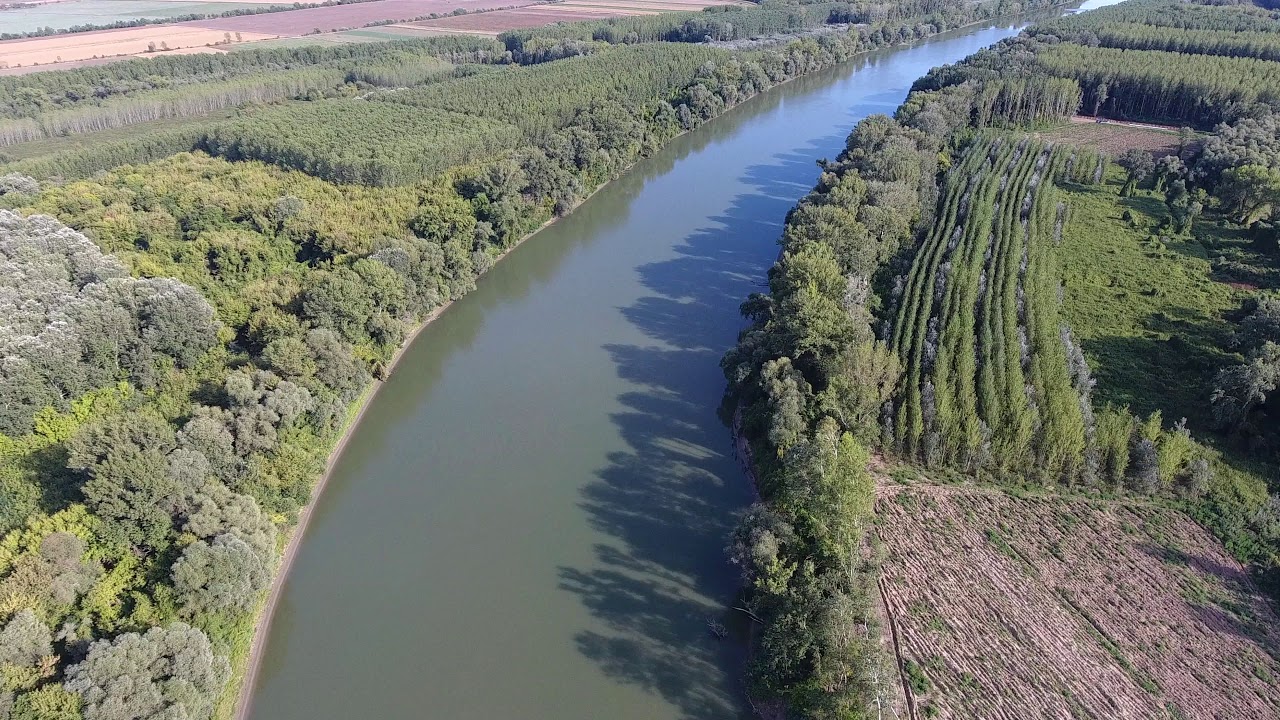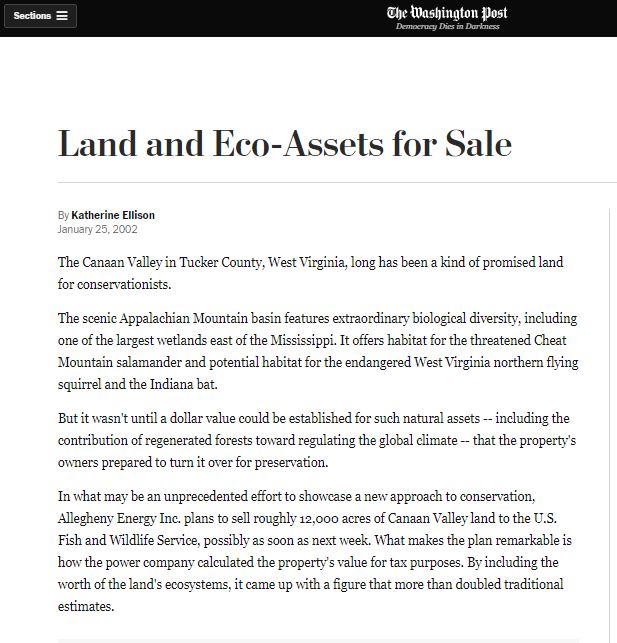McKinsey & Company, along with 3 other investment firms, requested copies of EASI's Mitigation Credit Price Report.
A local investment company requested a Mitigation Credit Price Report for the MidSouth region.
The European Institute for Energy Research requested a copy of EASI's entire Mitigation Credit Price Report.
Colliers International requested a Mitigation Credit Price Report for Southern California.
A residential developer requested a Mitigation Credit Price Report for six counties in central California.
A proof-of-concept for market based ecosystem restoration, specifically a wildland garden corridor between Knypersley Reservoir and Whitfield Valley Nature Preserve, was proposed to city leaders at Stoke-on-Trent in the UK. In cooperation with Vertis Environmental Finance.
Incentive based restoration and reforestation was studied for abandoned gravel mining operations near Szonbathely. In cooperation with Klimafa Inc.
Reforestation of portions of the Tisza River watershed in eastern Hungary was studied. In cooperation with Klimafa Inc. based in Budapest.
A week long briefing and California tour regarding eco-asset markets was given to Brice Quenouille, representing the French Society of Foresty based in Paris. Results supported France's compliance with the Carpathian Accord.
A landowner requested support for creating the Connolly Ranch Mitigation Preserve on 9000 acres located in Alameda County, CA. Authorized species credits were then applied in part to fulfill PG&E San Joaquin Valley HCP mitigation requirements.
Northeast Utilities requested an eco-valuation and restoration plan for natural resources impacted by operation of the Millstone nuclear generating station. An eco-restoration plan for lands surrounding Long Island Sound was proposed to Region I EPA. The company was granted a 5 year NPDES permit based on eco-restoration as a more relevant and valuable alternative to cooling tower construction. Results of this work then led to a regulatory amendment under Section 16b of the Clean Water Act, later referred to as an 'eco-technology alternative' to designated Best Available Control Technology.
A Superfund Site designation had been made for contaminated land draining into Boys Creek, an inflow to Buzzards Bay near Fairhaven, MA. The land contained high concentrations of heavy metals disposed during operation of the Atlas Tack Factory from 1900 to 1985. An eco-restoration plan for the site included acquisition of adjacent acres for mitigation bank development. Sale of mitigation credits would have offset overall site remediation costs.
Colliers International requested a site review of potential compensatory mitigation areas near Hennepin, IL, part of the North Central Illinois Economic Development Corporation.
American Electric Power requested an eco-valuation of mine restoration properties located in eastern Ohio, near McConnelsville.
Allegheny Power Company was the first to request an eco-valuation and appraisal for twenty thousand acres of the Canaan Valley near Davis, WV. Twelve thousand acres went to creation of the Canaan Valley National Wildlife Refuge, earning the company a $16M sale price, plus a $16M tax deduction based on the appraised value of ecological assets donated to the federal government.
Carolina Power & Light Company requested an eco-valuation for 3500 acres of land that had been offered for sale. A total of $122M in gross eco-asset value was identified, 10x more than company appraisers had priced the land's sale value.
A prospective buyer asked for an eco-asset valuation and business analysis for the historic, 10,000 acre, Half Circle L Ranch located near Immokalee, FL. A total of $330M in gross wetland and conservation value was identified for four tracts in the northern and western portions of the ranch. The buyer asked for a set of individual but linked business assessments for each of the four acquisition scenarios, providing him with variety of purchase options to be negotiated with the seller.
NextEra energy requested a statewide assessment of the performance, size and opportunity for wetland and stream mitigation banks in South Carolina.
Colliers International, conducting an appraisal of the Sequatchie Valley Mitigation Bank, requested an evaluation of the market value of ecological assets held by the landowner.
Ritchie Smith Associates of Memphis requested an analysis of the business considerations of developing portions of the Wolf River Greenway as flood water retention and recreation areas.
Texas Utilities requested a market-based valuation of preserved and restored woodland and grassland habitat surrounding the Big Brown generating station.
A landowner requested an eco-asset valuation to address emminent domain issues tied to creation of a water supply reservoir in NE Texas innundating portions of Boice d'Arc Creek.
Entergy Corp. requested an assessment of eco-value development and/or donation opportunities for undeveloped acres in the vicinity of the White Bluff generating station.
Entergy Corp. requested an assessment of eco-value development and/or donation opportunities for undeveloped acres in the vicinity of Port Jefferson, Mississippi.
Entergy Corp. requested an assessment of eco-value development and/or donation opportunities for undeveloped acres in the vicinity of the River Bend nuclear generating station. Donation of acres to The Nature Conservancy followed soon after.
Entergy Corp. requested an assessment of eco-value development and/or donation opportunities for undeveloped acres in the vicinity of the Sabine River generating station.
Agcoa Inc. requested a market based valuation and business analysis of eco-assets (mitigation credits) held by a nearby wetlands mitigation bank that had been offered for sale. The analysis showed that the bank's asking price was too high.
An eco-asset valuation was requested for 620 acres on Warm Spings Creek west of Anaconda, MT. A total of $14M in gross eco-asset value was identified. It was also learned that the State of Montana was seeking to add the land to the adjacent Garrity Mountain Wildlife Management Area. The landowner is now considering sale of his land to the State based on the net value of undeveloped ecological assets.
Working in concert with Wildlands Inc. staff, potential salmon restoration habitat was identified in the upper reaches of the Duwamish River southwest of Seattle.
A landower requested information on ecological asset values at Reinhart Canyon Ranch adjacent to the Owyhee Wild and Scenic River.
A landowner in Mendocino County, CA, requested information about mitigation credit values and mitigation bank development costs in order to comply with new regulations for county cannabis growers.
A landowner with title to water rights in the Klamath River Basin requested information about the potential value and mechanics of selling acre-feet into the California State Water Project.
A landowner requested an eco-asset valuation for 390 acres south of West Sacramento, CA. The land is sandwiched between the Sacramento River and river's Deep Water Ship Channel. A total of $4.7M in gross wetland and species mitigation credit value was identified for 100 acres of the farm.
A landowner requested an eco-asset valuation for the 160 acre West Island north of Antioch, CA, and close to the retired Kimball Island Mitigation Bank. A total of $28M in gross wetland, stream and species credits were identified for West Island.
Hatch Consultants requested a Mitigation Credit Price Report for the 9-county San Francisco Bay Area.
A landowner requested support, including Letters of Intent to Buy, supporting conservation easements and authorization of wetland and species mitigation credits. This became the French Ranch Conservation Preserve.
A landowner requested an eco-asset valuation and mitigatino credit market assessment for 8200 acres located west of Gilroy, CA.
A landowner requested an eco-valuation supporting potential wetland and conservation mitigation banking on 330 acres of ranch land. A total of $2.8M in species credits was identified. The landowner then sold 300 acres to a local energy company needing compensatory mitigation acreage. The eco-valued acres commanded 3x the traditional per-acre sale price for grazing land.
A landowner requested an eco-asset valuation and appraisal for 200 acres located in two parcels in the northern half of McDonald Island, located in San Joaquin County, CA. A total of $31M of gross wetland and species mitigation credits were identied, contributing to a net appraised value for the two parcels of $4.9M.
A landowner requested an eco-valuation for 695 acres located on Buttonwillow Slough, near Firebaugh, CA. A total of $41M in gross eco-asset value was identifed for wetland, stream and market-ready species credits that could be developed at the site. A hydrological survey was recommended as a next step.
The landowner asked for an eco-asset valuation for a potential 465 acre wetlands and conservation bank. A total of $23.5M in gross mitigation credit value was identified, and an in-depth biological assessment was recommended.
A landowner requested an eco-valuation for a 320 acre almond orchard that was to be split by the proposed California High Speed Rail corridor. The landowner considered a series of steps for the severed portions of the property, including sale of high grade fill dirt valued at $25M, creation of aquatic and wetland habitat inside the soil extraction area valued at $14M, and sale of recharged ground water to the California State Water Project valued at $7M per year.
PG&E requested evaluation of an 80 acre parcel of the Twissleman Ranch for conservation value based on the presence of several rare, creditable species. A conservation easement was established, and equivalent credits were transferred as mitigation offsetting nearby power line construction impacts.
A 2800 acre ranch and black walnut orchard was studied for its ecological asset value. A variety of scenarios were icompared with known local and national eco-asset valuations. A biological survey of the land was recommended, along with a more in-depth business analysis of the mitigation bank development opportunity.
Several properties in west Los Angeles County are under development as either In Lieu Fee mitigation or for market-based mitigation bank-and-sale. These projects are available for capitalization. The projects are expected to quickly sell authorized credits as PRM or as third party mitigation to satisfy local development demand.
Teichart Materials requested an eco-asset valuation for a heavily restored aggregate mine runoff pond at the Hallwood Facility near Marysville, CA.
A landower requested an eco-asset valuation for 1300 acres of patented and unpatended mining claims on Woodchopper Creek, a triburary of the upper Yukon River. The eco-asset values are to be applied when the landowner sells the land, the last remaining inholding of the Yukon-Charley National Rivers Preserve, to the U.S. National Park Service.
Terrace Mitigation Bank requested a loan from a local financial institution to support restoration of property wetlands habitat. Mitigation credits were offered as collatoral for the loan. The financial institution requested an eco-asset valuation and appraisal to confirm the economic status and market value of mitigation credits. Terrace Bank received the loan based on the results of the market based eco-valuation.
A landowner requested an eco-asset valuation and business analysis to support potential wetlands and conservation banking on a 2300 acre ranch on the Umatilla River west of Pendleton, OR. A total of $30M in gross eco-asset value was identified. Restoration costs, however, kept the net return on investment low. The landower has considered several strategies to defer or reduce project costs in order to boost mitigation bank ROI.
An eco-asset valuation and business analysis was performed to support potential wetlands and conservation banking on 1700 acres adjacent to Tenino, WA. A total of $43M in mitigation credit sales value was identified. The eco-asset valuation was followed by a land appraisal, where mitigation banking was defined as the land's highest and best use. The landowner is now offering to sell the land for future mitigation bank development.
Browse the map for more information about past projects.
Since the late 1990s, EASI team members have been engaged with companies, landowners, agencies and NGOs committed to discovering the ecological asset value of rural lands. Beginning with the Canaan Valley in 1998 — the nation’s first eco-asset based land appraisal (see article below) — a wide range of projects have been completed representing preservation, enhancement, restoration or even creation of ecosystem services. The ecological assets identified in these projects contribute to land revenues, to land appraisal and estate value, and to the permanent conservation of high quality rural lands.
The map represents more than 40 projects in the U.S. and Europe. Map pins contain brief statements about each project. Browse our website for more information, or contact us at info@easillc.com.


The Washington Post covered the Canaan Valley story in January, 2000. This was the first-ever land appraisal based on market ready ecological assets.
